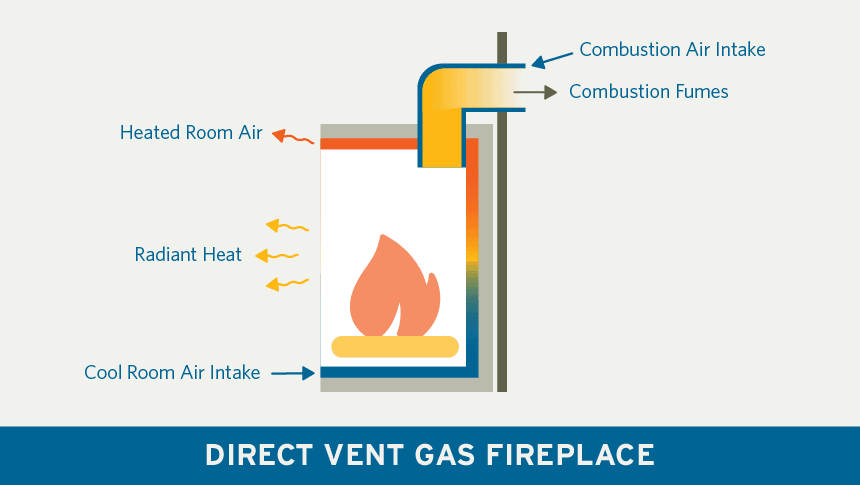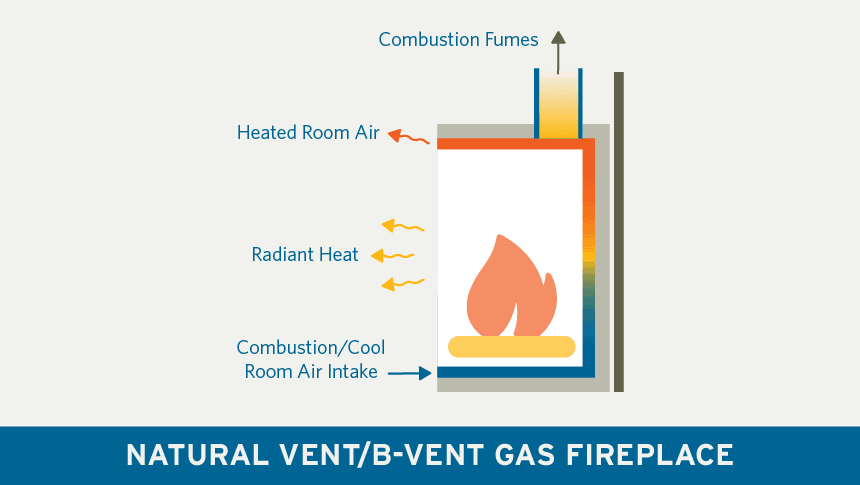Everything you need to know about gas fireplaces
Fireplace Updated: April 21, 2022Gas fireplaces: clean, safe and ultra-efficient

Gas fireplaces: clean, safe and ultra-efficient

During the dreariest months of winter, a cozy fireplace scene is difficult to resist.
While a wood-burning fireplace has its appeal, if you’re looking for a more sustainable option, you may want to consider going with gas. Modern gas fireplaces are cleaner-burning, safer and far more energy efficient – in fact, they can reach efficiency ratings of up to 90%.
Some of the other advantages of gas fireplaces include:
Whether you’re interested in saving energy or money, gas fireplaces do both. Installing a gas fireplace in the most used area of your home can help you save on heating bills, and it’s hard to beat the ease, comfort and convenience of lighting a fire with the flip of a switch.
Essentially, a gas fireplace produces sustained fire using three basic mechanisms: air intake, combustion and exhaust.
There are also three types of gas fireplaces: direct vent, natural/b-vent and ventless. We’ll focus on the first two, as ventless gas fireplaces are typically not intended to provide heat to a home, and can cause unsafe indoor air quality and other safety concerns.
The main difference between a direct vent and a natural/b-vent gas fireplace is how they cycle air and exhaust.
A direct vent fireplace has two separate and sealed off pipes traveling between the fireplace and the outdoors. It pulls fresh air from outside through one pipe to create combustion – aka, fire – and then pushes out exhaust fumes through a different pipe.
A natural/b-vent gas fireplace pulls air from inside the room to create combustion and then uses a special b-vent pipe to exhaust fumes outside through a single flue. The flue is a dedicated chamber or pipe used to transfer combustion air/gases from the fireplace to the outside.

One of the biggest advantages of gas fireplaces over wood burning fireplaces is their incredible efficiency. Unlike traditional fireplaces, which lose much of their heat straight up the chimney, direct vent gas fireplaces keep up to 70% of heat inside of your home.
The dual flue of a direct vent means that the fire will burn hotter and more efficiently – and due to its tight seal, cold air won’t leak in when you’re not using your fireplace.
Direct vents also have more installation options. Your home doesn’t need an existing chimney and the direct vent pipes used for intake air and exhaust can route horizontally through the side of your home as well as vertically through the roof. That means you can safely install a gas fireplace nearly anywhere, whether that’s a kitchen, bedroom or even a bathroom.

While natural vent fireplaces don’t convert heat as efficiently as direct vents do, they are still vastly superior to wood-burning fireplaces.
B-vents are a popular option for remodels, as they don’t require as much clearance to install, and can use an existing masonry chimney or a metal chimney. They might also be a good choice if you’re looking for a flame that’s aesthetically closer to a wood-burning fire, since b-vent fireplaces produce larger flames.
Some disadvantages of b-vents include hotter combustion gases (exhaust) and potentially an increased opportunity for cold air to leak into your home.
Gas fireplace inserts
If you have an existing masonry fireplace that you’d like to convert to gas, installing a fireplace insert could be a great option for your home. Gas fireplace inserts are self-contained chambers constructed of steel or cast iron that can operate with either natural or direct vent systems.
Gas fireplace styles
Whether you prefer traditional ceramic “logs” or a more modern look of flames burning among sand or glass rocks, there are plenty of styles to choose from. You can even find gas stoves that mimic the look of rustic wood-burning models.
Electronic ignition vs standing pilot ignition
A final thing to consider if you’re in the market for a gas fireplace is the type of ignition. A fireplace with electric ignition uses a spark created by electricity to ignite the flame, much like a gas stove burner. A standing pilot ignition uses a low amount of gas to continually maintain a small flame. Electronic ignition is standard for most gas fireplaces, but some models do feature standing pilot ignition. If it’s important to you to be able to use your gas fireplace during a power outage, a standing pilot might be something you want to consider (even though it costs a bit more to operate). A newer electric option is an intermittent pilot ignition, which uses an electric ignition to ignite the flame only as needed, plus a battery backup for outages.
If you’re ready to make the upgrade to an energy-efficient gas fireplace, Energy Trust of Oregon is here to help. When you add or replace a qualifying gas fireplace, you can get cash back with our fireplace incentive. Let an experienced contractor from our extensive network walk you through finding the right fireplace upgrade for the best price.
